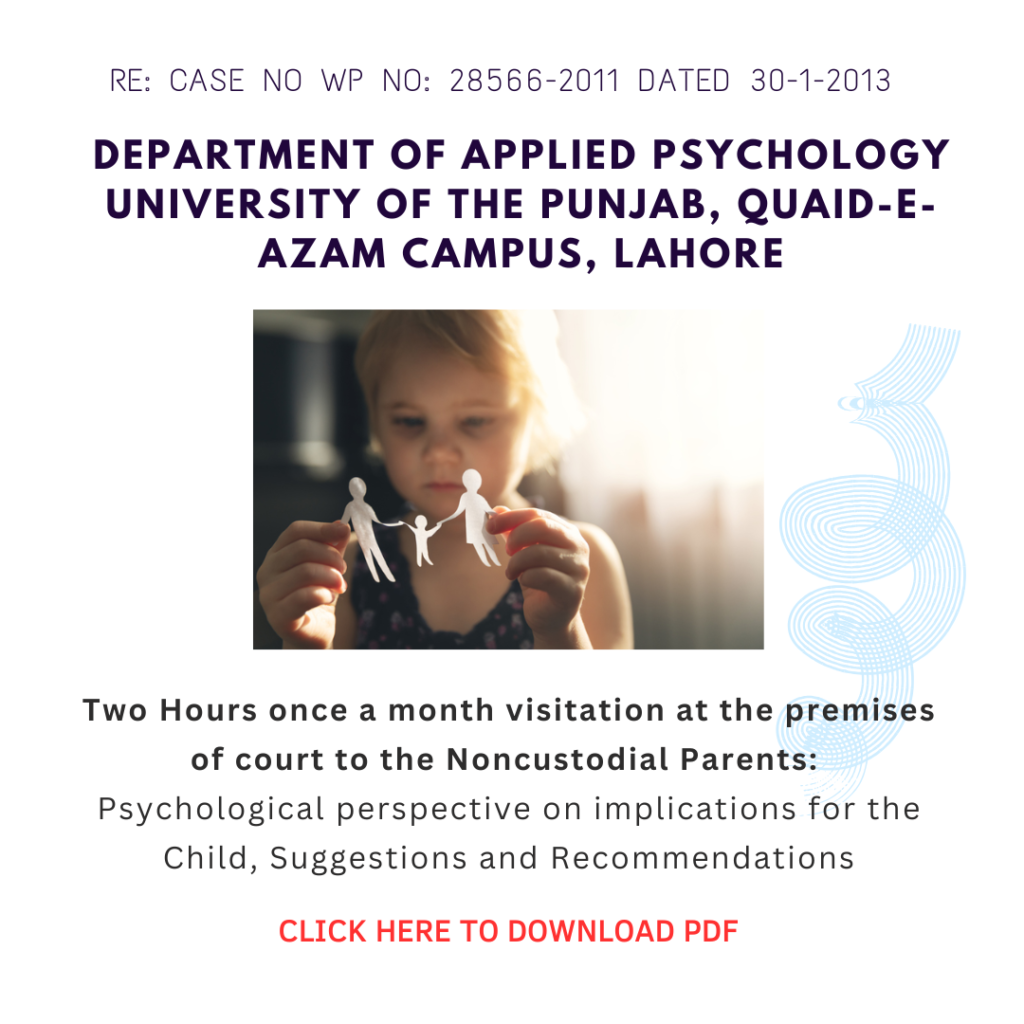Wasim Law Services
How to get child custody as a father
Categories
why choose us
- Years Of Experience
- Experienced Attorney
- Free Consulting
Download Profile
Important Case Laws
How to get child custody as a father
In Pakistan, obtaining a visitation schedule from the court involves filing a petition under the Guardians and Wards Act, 1890. Courts prioritize the best interests of the child while deciding on visitation rights. Here is a step-by-step guide to help you through the process:

Step1 Get a Visitation schedule
1. Ensure the lawyer is well-versed in the Guardians and Wards Act, 1890, which governs custody and visitation matters in Pakistan.
2. File a Visitation Petition in the Family Court of the district where the child resides.
3. The petition should include:
Your relationship to the child.
The current custody arrangement.
Specific visitation rights you are seeking (e.g., weekly visits, holidays, or overnight stays).
4. (i)Your role in the child’s upbringing (e.g., photos, financial support receipts, or testimony from others).
(ii)Your ability to maintain a safe and nurturing environment for the child.
(iii)Any history of denial of visitation by the custodial parent.
5: Court’s Decision
The court will evaluate factors such as:
The child’s age and needs.
The existing bond between the child and the non-custodial parent.
The custodial parent’s objections, if any.
Any specific circumstances, such as the child’s schooling or health requirements.
Based on this assessment, the court will issue a visitation schedule that may include:
Daytime visits (e.g., weekends or holidays).
Overnight stays (if the child’s age and circumstances allow).
Extended visits during school vacations.
7. Enforce Your Rights (If Necessary)
If the custodial parent denies visitation despite the court order:
File a contempt of court petition to enforce your visitation rights.
The court may impose penalties on the custodial parent or through warrant and police assistance can implement the order if violations persist.
Step2 Get Home Visitation schedule
In family law, home access refers to the legal right granted to a non-custodial parent to spend time with their child, often at their home, to strengthen the parent-child bond. Courts recognize that maintaining a healthy and nurturing relationship with both parents is critical for a child’s emotional and psychological well-being. The decision to grant a father home access or visitation rights to a child, including a 3.5-year-old, depends on the child’s welfare and case-specific circumstances. Courts rely on legal precedents and statutes, primarily the Guardians and Wards Act, 1890, to ensure decisions align with the child’s best interests.
Best Interests of the Child:
Courts prioritize emotional and physical stability for the child.
If the father can demonstrate that home access will benefit the child and ensure a loving relationship, the court may allow it. In Pakistan, the decision to grant a father home access or visitation rights to a child, including a 3.5-year-old (PLD 2018 Baluchistan 44). Courts rely on legal precedents and statutes, primarily the Guardians and Wards Act, 1890, to ensure decisions align with the child’s best interests.
Legal Principles for Granting Visitation Rights
For children under the age of seven, especially toddlers and preschoolers, custody is generally granted to the mother unless she is deemed unfit (e.g., due to immoral character, neglect, or inability to provide care).
However, the father retains the right to visitation, which may include home access, if it does not disrupt the child’s routine or emotional well-being.
Best Interests of the Child:
Courts prioritize emotional and physical stability for the child.
If the father can demonstrate that home access will benefit the child and ensure a loving relationship, the court may allow it.
Case Law Supporting Father’s Visitation Rights
Key Considerations for Fathers Seeking Home Access
When requesting home access for a 3.5-year-old, the court evaluates:
Parental Relationship: The father’s prior involvement in the child’s upbringing.
Safety and Stability: Whether the father’s home environment is safe and child-friendly.
Mother’s Consent or Objection: If the mother raises concerns, the father must address them with evidence (e.g., proof of care and support).
Emotional Bond: The court may allow home access if it fosters a strong relationship between father and child.
Challenges and Resolutions
Mother’s Objection: If the mother contests home access, the court may appoint a mediator or conduct an in-camera interview with the child to assess comfort levels.
Supervised Visits: The court may initially allow supervised home visits before granting unsupervised access.
Step 3 Application of Section 17(3) of guardian and ward act 1890
When invoking Section 17(3) in a custody or guardianship case:
Petitioner’s Argument:
Highlight that the child is of sufficient age and maturity to express a preference.
Request the court to consider the child’s preference as part of its decision-making process.
Court’s Approach:
Evaluate the child’s age, maturity, and emotional understanding.
Balance the child’s preference with other factors affecting their welfare, such as:
The ability of the proposed guardian to provide a safe and nurturing environment.
The emotional and financial stability of the guardian.
The overall well-being and development of the child.
Impact of the Child’s Choice:
While the child’s preference is influential, it is not binding. The court retains the authority to decide contrary to the child’s wishes if it deems it necessary for their welfare.
- Share On

